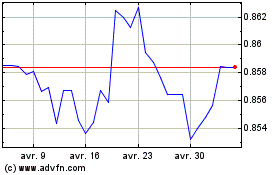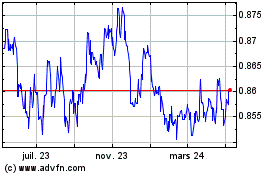UK Industrial Production Growth Slows On Oil & Gas Extraction
08 Septembre 2017 - 10:12AM
RTTF2
UK industrial production grew at a slower pace in July amid the
weakness in oil and gas extraction and a bigger-than-expected
decline in construction output due to fall in new work.
Industrial production grew 0.2 percent month-on-month in July,
slower than the 0.5 percent increase seen in June, data from the
Office for National Statistics showed Friday. The monthly rate came
in line with expectations.
The expansion was largely driven by manufacturing output, which
advanced 0.5 percent led by car production. Factory output expanded
for the first time so far this year. Economists had forecast a
moderate growth of 0.3 percent after stagnation in June.
Meanwhile, the mining and quarrying output fell 1.2 percent as
oil and gas extraction contracted 1.4 percent.
Year-on-year growth in industrial production improved marginally
to 0.4 percent in July, while the annual rate was expected to
stabilize at 0.3 percent.
Manufacturing output increased 1.9 percent annually after
expanding 0.6 percent a month ago. The pace of expansion was
forecast to accelerate to 1.7 percent in July.
Another report from the ONS showed that the construction output
fell 0.9 percent in July from June, driven by a 1.4 percent drop in
all new work. Output was forecast to ease 0.3 percent.
In a separate communique, the ONS said the visible trade deficit
widened in the three months to July, primarily due to an increase
in the imports of finished manufactured goods.
The visible trade deficit increased by GBP 1.1 billion to GBP
34.4 billion in the three months ended July.
The total trade including goods and services showed a shortfall
of GBP 8.6 billion primarily due to the widening of goods deficit,
which was partially offset by a widening of the trade in services
surplus by GBP 0.7 billion.
In July, the total trade deficit was almost stable at GBP 2.87
billion. At the same time, the visible trade deficit totaled GBP
11.57 billion in July compared to GBP 11.53 billion in the previous
month.
Today's flurry of activity data suggests that external-facing
sectors are still providing little offset to the consumer slowdown,
Ruth Gregory, an economist at Capital Economics, said. But there
are some signs that net trade could provide more support in the
quarters ahead.
Elsewhere, the British Chambers of Commerce on Friday upgraded
its UK growth forecast for this year to 1.6 percent from 1.5
percent, citing moderately stronger outlook for consumer spending
growth.
However, the outlook for 2018 and 2019 were lowered to 1.2
percent and 1.4 percent, respectively. A weaker contribution from
net trade and more subdued consumer spending growth were the main
reasons for the slight downgrade, the lobby said.
According to the BCC, the first increase in UK official interest
rates, to 0.5 percent, will occur in third quarter of 2018.
Euro vs Sterling (FX:EURGBP)
Graphique Historique de la Devise
De Mar 2024 à Avr 2024

Euro vs Sterling (FX:EURGBP)
Graphique Historique de la Devise
De Avr 2023 à Avr 2024
